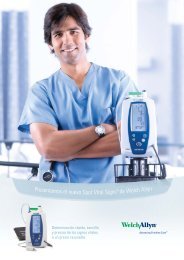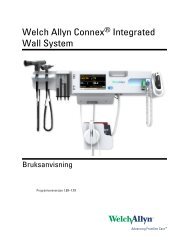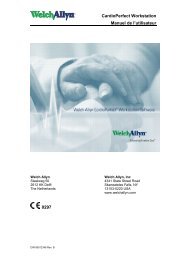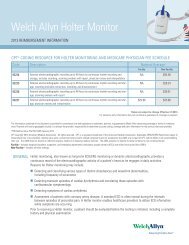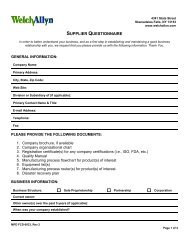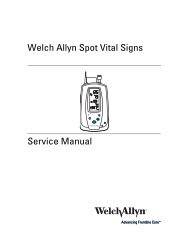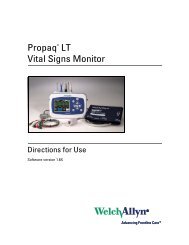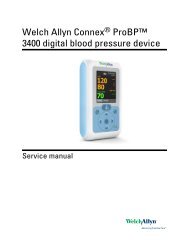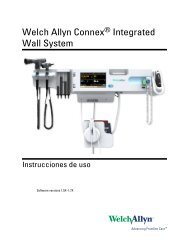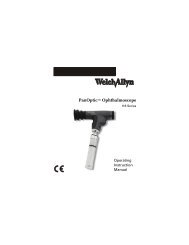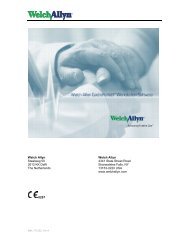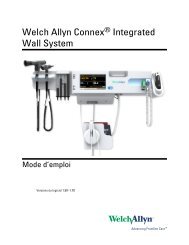Reference Guide - Propaq Encore Vital Signs Monitor - Welch Allyn
Reference Guide - Propaq Encore Vital Signs Monitor - Welch Allyn
Reference Guide - Propaq Encore Vital Signs Monitor - Welch Allyn
Create successful ePaper yourself
Turn your PDF publications into a flip-book with our unique Google optimized e-Paper software.
42 Patient monitoring <strong>Welch</strong> <strong>Allyn</strong> <strong>Propaq</strong> <strong>Encore</strong> <strong>Vital</strong> <strong>Signs</strong> <strong>Monitor</strong><br />
NIBP<br />
Intended use<br />
The <strong>Propaq</strong> <strong>Encore</strong> noninvasive blood pressure channel (NIBP) indirectly measures arterial<br />
pressures using an inflatable cuff. If ECG is also monitored, the <strong>Propaq</strong> <strong>Encore</strong><br />
synchronizes the NIBP measurement process to the occurrences of the R-wave,<br />
increasing accuracy in cases of extreme artifact, diminished pulses, or some<br />
dysrhythmias.<br />
WARNING The patient's limb should be periodically observed to ensure that the<br />
circulation is not impaired for a prolonged period of time.<br />
WARNING The <strong>Propaq</strong> <strong>Encore</strong> should never be used to monitor NIBP on one<br />
patient while simultaneously monitoring ECG on another patient.<br />
WARNING If a noninvasive blood pressure measurement is suspect, repeat the<br />
measurement. If you are still uncertain about the reading, use another method.<br />
WARNING Do not attempt to take NIBP pressures on patients during<br />
cardiopulmonary bypass.<br />
WARNING Some or all NIBP safety functions are disabled in the NIBP TEST<br />
screen in the Service Menu. Do not attempt to conduct NIBP TEST when the cuff<br />
is attached to a patient.<br />
The <strong>Propaq</strong> <strong>Encore</strong> NIBP channel has been calibrated to agree with a central invasive<br />
blood pressure. Diastolic pressures may be 5 to 10 mmHg lower than the auscultatory<br />
equivalent. Systolic pressures may be lower than radial invasive equivalent.<br />
Neonatal Mode is intended for use on infants of up to about 44 weeks gestational age in<br />
neonatal care settings. The Neonatal Mode provides the lowest cuff pressure and<br />
shortest inflation time limits to ensure patient safety and comfort.<br />
Pediatric Mode is intended to be used on larger infants and small children up to nine<br />
years old in pediatric care settings. This mode supports the widest range of cuff sizes and<br />
a higher range of patient numerics for the hypertensive infant or child while still restricting<br />
the cuff pressure and inflation times to limits lower than those allowed for adults.<br />
Adult Mode provides the full range of patient numerics and cuff pressures but limits the<br />
cuff sizes available to the standard child cuff and larger.<br />
NIBP measurements are affected by normal physiological pressure variations from<br />
reading to reading. Normal respiration may affect pressure by as much as 10 to 20 mmHg.<br />
Patient’s emotional state, body position, and cuff fit may also adversely affect NIBP<br />
measurements. In some individuals, the act of taking blood pressure readings may alter<br />
the blood pressure. Successive readings on the same patient may vary for the above<br />
reasons.<br />
The static accuracy of the <strong>Propaq</strong>’s internal manometer can be verified by a qualified<br />
biomedical engineer using a mercury column manometer (refer to the <strong>Propaq</strong> <strong>Encore</strong><br />
Service Manual). The accuracy of the <strong>Propaq</strong>’s determination of systolic, diastolic, and<br />
mean pressures in a clinical setting can only be assessed by careful statistical analysis of<br />
controlled clinical trials of representative patient populations.



